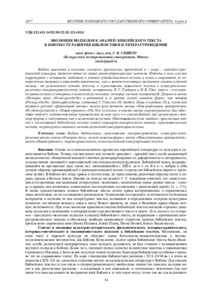Пожалуйста, используйте этот идентификатор, чтобы цитировать или ссылаться на этот ресурс:
https://elib.psu.by/handle/123456789/20858| Название: | Эволюция подходов к анализу библейского текста в контексте развития библеистики и литературоведения |
| Авторы: | Синило, Г. В. |
| Дата публикации: | 2017 |
| Издатель: | Полоцкий государственный университет |
| Библиографическое описание: | Вестник Полоцкого государственного университета. Серия A, Гуманитарные науки. - 2017. - № 10. – C. 34-45. |
| Аннотация: | Библия, выступая в качестве «осевого» архетекста европейской и – шире – иудейско-христианской культуры, является одним из самых реинтерпретируемых текстов. Подходы к нему в целом коррелируют с основными подходами к анализу художественного текста в целом и отражают их иcторическую динамику и взаимообусловленность, что и является основным предметом анализа в данной статье: от религиозного метода экзегезы и герменевтики священного текста к культурно-историческому литературоведческому подходу, основанному И. Г. Гердером и И. В. Гёте, затем – к историко-критическому и историко-генетическому методам, которые сменили основанная В. Дильтеем школа «Истории духа» (Geistesgeschichte) и возникший в ее рамках метод «анализа форм», или жанров (Formgeschichte, Gattungsforschung), созданный Г. Гункелем (H. Gunkel). Лишь к середине ХХ в., когда под влиянием русской «формальной школы» начала века возникли школы «Интерпретации произведения» (Werkinterpretation) и «Новой критики» (The New Criticism), а также школа структурализма, был обоснован подход к художественному произведению (в том числе и к книгам Библии) как органичному единству формы и содержания, как к целостной вселенной. Обосновывается как наиболее приемлемый подход к исследованию библейского текста синтез культурно-исторического анализа, герменевтического метода, структурного анализа и метода целостной интерпретации текста.= the Bible, as the «axial» archetext of European and – more widely – Judeo-Christian – culture, is one of the most reinterpreted texts. Approaches to it correlate with the main approaches to the analysis of the artistic text as a whole and reflect their historical dynamics and interdependences. That is precisely the subject of analysis in this paper: from the religious method of exegesis and hermeneutics of the sacred text to the cultural and historical literary approach based on J. G. Herder and J. W. Goethe, then to the historically-critical and also historically-genetic methods, which were replaced by the «The History of the Spirit» (Geistesgeschichte) school founded by W. Dilthey and the method of «Form Criticism», or genre criticism, born out of it (Formgeschichte, Gattungsforschung) and created by H. Gunkel. Only by the middle of the 20th century, when the schools of «Work Interpretation» (Werkinterpretation), «The New Criticism», and the school of structuralism appeared under the influence of the Russian «Formal School», did the approach to the work of art (including the Bible) as an organic unity of form and content, as an integral universe, finally emerge. In this paper, the synthesis of cultural and historical analysis, of the hermeneutic method, structural analysis and the method of total interpretation of the text is seen as the most acceptable approach to the study of the biblical text. |
| Ключевые слова: | Государственный рубрикатор НТИ - ВИНИТИ::ОБЩЕСТВЕННЫЕ НАУКИ::Литература. Литературоведение. Устное народное творчество Библия Библеистика Герменевтика Литературоведение The Bible The Bible Studies Hermeneutics Literary criticism |
| URI (Унифицированный идентификатор ресурса): | https://elib.psu.by/handle/123456789/20858 |
| Права доступа: | open access |
| Располагается в коллекциях: | 2017, № 10 |
Файлы этого ресурса:
| Файл | Описание | Размер | Формат | |
|---|---|---|---|---|
| 34-45.pdf | 396.66 kB | Adobe PDF |  Просмотреть/Открыть |
Все ресурсы в архиве электронных ресурсов защищены авторским правом, все права сохранены.